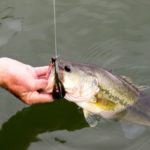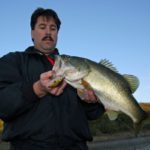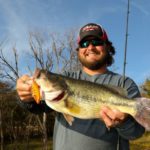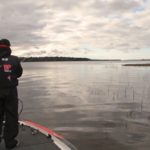
Yeah, it’s cold this month, but if conditions get right bass will be thinking about the spawn — and that makes them vulnerable. Use these pro tips to catch more pre-spawners.
They want to go. They probably will go; it’s just a matter of when they’ll go.
That’s the usual fickleness of pre-spawn bass.
Transitioning from winter patterns into the necessary fattening-up period prior to procreation takes a time and adjustment.
“When it’s right, they’re coming,” Bassmaster Elite Series pro Cliff “Cajun Baby” Crochet said.
The show schedule might vary lake to lake, and seasonal conditions have a deep influence. However, those willing to pay the penance of patience can uncover a gold mine of opportunity.
Here are a few thoughts to help figure out when and where nature flips the pre-spawn switch — and how you can facilitate the process.
Early goings
It’s the stuff of legends — locked and loaded pre-spawners blasting anything they see.
It’s definitely a cool deal; just don’t rush things. Remember, the seasonal transition from cold to warm includes a not-so-cold level during which fish are lacing up their chasing shoes — but they’ve yet to hit the track.
Favoring a slower, methodical presentation for the early pre-spawn, Elite Series pro Gerald Swindle likes a football head jig.
He’ll throw this on creek channel bends, secondary points with cover and riprap corners he finds around like bridges, marinas and residential areas.
“Those are areas where the fish are trying to move up, and those are some of their first stops,” Swindle said. “The water’s starting to warm up, the bait is moving in and the fish will move onto that piece of structure and sit.
“When they get there, they’re not always active in a way where they’re chasing everything down. So you can drag that football head with a Zoom Super Chunk — it’s just a very lethargic bait with a subtle flapping.”
As Swindle noted, you might reach such spots with a moving bait like a Storm Wigglewort, but if the fish aren’t ready you’re wasting your time.
But hit them with that slow-moving football head — or even a shaky head or drop shot — and they’ll often take you up on the offer.
“Sometimes people think ‘I’m trying to catch big ones,’ but sometimes those pre-spawn fish don’t want huge baits,” he said. “Just because that fish moves into position doesn’t mean he’s feeding; he’s just taking a natural route. The bait’s moving and he’s moving up with it, but that doesn’t mean he’s starving to death.
“That’s what trips people up when they think about flipping the pre-spawn switch. It doesn’t mean the fish have gone into beast mode and they’re eating every minnow in the lake — it means they’re getting into position.”
Swindle lets weather guide his game plan.
“When you start getting some warmer nights — I mean, if it’s been in the 30s every night, and then you start getting 45 every night — you’ll see the fish flip that pre-spawn switch and start biting a little better.”
Increasing aggression
There’s never an exact schedule for when the pre-spawn switch will flip, but you can bet that once the fish feel the right water temperature it’s like a bold cup of Community Coffee — eyes wide open, fire in the backside and full steam ahead.
“That’s when you start hearing guys talking at the coffee shop about, ‘Good Lord, I had a bite on a jig and he thumped it so hard it liked to scared me to death,’” Swindle said. “Well, (the fish’s) mode kinda changes; he’s adapted to the warmer water and he’s starting to feed.
“I tell people to pay attention to the bite to tell how far along they are in the pre-spawn. Are the fish really getting fired up, or are they just getting there?”
If Swindle’s getting solid jig bites, he’ll switch to a diving crankbait. Some might have trouble warming up to this idea when the water’s in the low 50s, but don’t underestimate a motivated pre-spawner.
“Those pre-spawn fish are big, they’re hungry and when they get aggressive like that they’ll bite that crankbait,” Swindle said. “Some of the best days I’ve had have been when the water was 51 to 52 degrees and I was throwing a big DT14. The fish at that time are telling you, ‘We’re active, we want to eat, we want bigger baits.’
“Most of the time that’s not in a fisherman’s mind set; they’re thinking it’s been cold. But if you’re getting aggressive strikes on that jig, drop a crankbait and see if you can get a bigger bite.”
But there’s a limit to the fish’s aggressiveness, he said.
“You’re not burning it; you’re just slow reeling it,” Swindle explained.
Maximum motion
For active pre-spawners in shallower areas, Louisiana’s Crochet is a fan of the lipless crankbait’s fish-calling vibrations.
Throwing the original Rat-L-Trap in crawfish colors, Crochet believes in targeting the most-aggressive — typically the biggest — fish and then downshifting if needed.
“If they want to play, we can play — wide open the whole time,” he grinned. “I’ll start off with a fast, aggressive retrieve — it’ll be a mix of steady reeling, twitching and dropping, but 80 percent of the retrieve will be moving the bait.
“If you’re catching them, you’re catching them. If you’re getting a lot of misses — just swipes and not hooking up — or no bites, I turn everything down.”
By that, Crochet means he’ll slow his retrieve and go with short, sharp pops; or he’ll go silent with the Stealth Trap.
Another option: Change the sound from that “crazy, crazy” of a traditional Trap to the low thunk-thunk-thunk of the new Knock-N Trap.
Pre-spawners will also smash a squarebill crankbait, so pair this with your lipless attack for thorough coverage.
The squarebill’s a good bet for banging off shallow staging cover, but in the grass it offers the benefit of flotation. Kill the retrieve and the bait rises to hold at the surface in a fish-taunting display.
Elite Series pro Greg Vinson adds a ½-ounce spinnerbait into the because he can make longer, faster and more-accurate casts.
He typically uses double willow blades, but if the water’s cooler and he needs to slow his bait, he’ll upsize the blades to as big as No. 7 to decrease his speed, enhance the profile and provide more lift to keep the bait off the bottom when slow-rolling.
Pre-spawn targests
Explaining his general pre-spawn location plan, Vinson said it’s all about structure.
“There’s always a channel or a drain that leads into the spawning creeks, and anytime you have a point that meets that channel, you’re going to have a drop-off,” he explained. “It might not necessarily be a ledge; it will just be a quick drop. That acts as a safety zone for the fish as they’re staging.”
Vinson stressed the wisdom of thorough site analysis — broad-scale first and then a fine-tuned effort to dial in specifics.
“I really look at the structure first, and then I adapt my presentation to whatever cover is available,” he said. “If the grass is really thick, I’ll throw a lipless bait and use heavier line to keep it from burying up as much. If the grass is short and stumpy, just off the bottom, I can go to lighter line and a little slower retrieve.
“I want to tick the top of the grass, however tall it is, so I’ll adjust my speed of retrieve and line size to be able to tick the top of the grass on the retrieve.”
For finding his targets, Vinson leverages multiple sonar looks to identify the most-promising areas. Side-scanning sonar helps him spot promising clumps of grass that he’ll then inspect from above.
“A down-view perspective will give you a much better feel for what’s there,” he said. “Exactly how tall and how thick is that clump of grass? That’s what the side and down views will give you.
“I look at the grass in terms of how does it look relative to what’s around it. If it’s thicker and taller than anything within 100 yards, then that’s going to be a key target — especially if it’s already positioned in a good structure area.”







